The carpentry field requires you to have a plethora of tools at your disposal. Each piece of equipment is unique in its abilities and limitations. Power saws, for instance, are as varied as skittles and each one has a place in your tool vault. From the lowly but crucial circular saw to the arc cutting jigsaw, all fulfill a necessary element in wood crafting. I am always on the lookout for new tools to add to my inventory so when Pro Tool Reviews asked me to review the Makita SP6000J Track Saw I was intrigued. What can a track saw add that my others cannot?
Makita SP6000J First Impressions
The Makita brand has been one of my favorites for years. Makita makes a great saw that is a proven performer in the field. Outstanding stock blades and direct drive motors on several of their saws have set them apart from the field.
Read our Review of the Makita Flagship Direct-Drive Miter Saw
The Makita SP6000J arrived in mint condition. The saw itself comes in a form-fitting hard case that is well built and stackable. Makita also sent along a guide rail, rail clamps, and rail angle guide. All the components were equally well packaged and undamaged.
After unpacking, I took some time to familiarize myself with the different components before I put them to work. The Makita Track Saw was accurate right out of the box and needed no adjustment for 90, 45, or 22.5 stop sets. The rail was perfectly straight and flat when laid on sheet goods and held its place well.
The Field Test
My son and were in the beginning stages of a banquette and table build so what better way to put this new addition through the paces?
Guide Rail Setup
The guide rail has several rows of gripping strips on the side that contact the work surface and it does an amazing job of keeping the rail in place. When you first use the rail you will need to adjust the rail slides on the saw. Adjust the two round knobs should until you have no lateral movement on the rail while maintaining a smooth sliding action.
I should also mention that as part of the setup you will need to make a pass through a scrap piece to allow the saw to align the chip guard (black rubber edge on the outside of the rail) with the blade. This allows you to properly align the rail for your cuts.
First Cuts
After the alignment pass, I proceeded to the first cut. I was sawing some birch veneer panels so I opted to use Makita’s’ innovative score setting. On the side below the trigger housing, there is a green button that when depressed only allows the saw to cut 2 to 3 mm deep (~1/16-inch). This feature reduces chipping of the veneer perfectly as the saw does not bring panel waste from below through the cut. The results of the first cut were quite impressive resulting in a clean, accurate, chip free finish. Subsequent cuts were also above par.
The Real Test
The first real test was to break down some 3/4-inch cabinet grade panels into build components. Cross cutting panels on the table saw in our shop has always been a two-person gig as the left-hand outfeed is only two feet wide. The Makita Track Saw made this a breeze. Placing the sheet on our build table, I was able to comfortably and accurately saw the sheet to size on my own. For this exercise, I didn’t use the angle guide but simply aligned the track with measurements I had made.
Depth Scale
The SP6000J has a depth scale in front of the motor that is simple and well laid out although it is in metric. That’s a funny thing since most carpentry work is in imperial measurements. But that being said, with a few calculations on my slide rule and abacus, I was able to set the depth to 21 mm – or a hair over 3/4-inch for us old guys.
Plunge Cutting
The reverse plunge action of the Makita Track Saw takes a little getting used to for those of us familiar with plunge cutting using a standard circular saw. Once you acclimate, the action is smooth and effortless. Depressing the plunge release button on the handle opposite the trigger is natural and Makita did a great job with ergonomics.
Dust Collection
The dust collection for the Makita SP6000J track saw is above average, leaving little residual sawdust and scant airborne particles. While Makita does have a dust bag accessory, we connected ours to *cough* Festool’s dust extractor system that fit it perfectly. Now that I mention it, the case fits the Festool Systainer boxes perfectly as well. Even my son and partner Matt – who scoffs at most things not Festool – was impressed.
Clamps
After breaking down several panels, I utilized the rail clamps to hold the track to the sheeting. The clamps are a nice feature, easy to use, and plenty capable of securing the track to the workpiece when you need that extra level of security.
Variable Speeds
One unique feature added to the Makita Track Saw is a thumb wheel below the trigger that allows you to set the saw speed from 2000 to 6400 RPM. Why you ask?
Think plastic laminates and other composite sheets that will melt at high RPMs. The adjustment allows you to cut a full range of modern materials. The 12-amp motor also features soft start technology, ending those torque related mishaps as well as electronic speed control that keeps your RPMs up during the cut.
Bevel Guide
The bevel guide located at the front and rear has an easy to read layout as well as 4- and 22.5-degree positive stops. The maximum bevel is 48 degrees which aids in those funky angles we run into. And if you find the occasion to use it, there is also a 1-degree counter bevel. Why is that important?
A 1-degree relief allows for extremely tight joinery when fitting panels.
Compounds Miter Cuts
The best feature for me personally is the Makita Track Saw’s ability to make really lonnnnnng compound MITER cuts. What used to be the domain of the table saw and a taper jig can now be done quickly and accurately with the track saw. Makita has included a button that clips the saw to the rail allowing you to bevel the body of the unit while the plate stays in place on the track. This process is further simplified by the blade entering the work surface at the same place square or beveled. Using Makita’s innovative track angle accessory you set your angle, rotate the bevel, and cut textbook compound miters as long as you want.
Final Thoughts
A track saw has a definite place in your tool corral if you break down panels for cabinetry, straighten crowned lumber, or need quick and accurate compound miters. The Makita SP6000J is certainly more than capable of producing excellent results while being easier on the budget than a lot of their competitors. The only flaw I could find was the lack of a riving knife, which can lead to kickback if you’re not cautious. Otherwise, it’s a solid performer in the field or shop.
Makita Track Saw Manufacturer’s Key Features
- 12 Amp motor with variable speed control dial (2,000 – 5,200 RPM) for optimum performance in a variety of materials
- Large cutting capacity (2-3/16″ at 90° and 1-9/16″ at 45°)
- Bevel capability (-1 to 48°) with positive stops at 22.5° and 45°
- Close to the wall cutting (11/16″) for expanded cutting applications
- Ideal for cutting large wood panels and other wood materials in confined areas
- 1-1/2″ OD dust port directs material away from the operator and connects to a vacuum system
- Electronic speed control maintains constant speed under load for smooth cutting
- Built-in current limiter helps prevent motor burnout
- Soft start feature for smooth start-ups
- Easy-to-set depth adjustment with large scale
- Smooth and convenient plunge release lever for operator comfort
- Magnesium components deliver a well balanced and lightweight saw at only 9.7 lbs.
- Dual front and rear bevel supports provide additional rigidity for precise and accurate bevel cuts
- Precise bevel cutting as the position of the blade enters the material on the same cutting line whether cutting straight or bevel
- Locking lever holds the blade in position so that the wrench can be inserted through the hole in the blade case for easier blade installation
- Blade wrench attaches to the saw for fast and convenient blade changes
- Built-in depth stop allows a preliminary cut of 1/16″ to be performed before the entire material is cut through for clean and splinter-free cutting
- Rubberized handles for added comfort
- Large 1-7/16″ rear dust port directs material away from the operator and easily connects to a vacuum system
- Includes a premium 48 tooth carbide tipped blade
- Optional guide rail system interacts with the saw base to provide smooth, perfect, dead-on straight or bevel cutting (available as SP6000K1)
- Saw base is attachable to other guide rail systems in the market
- Optional Accessories: Guide Rail:117″ – 194367-7, 54″ – 194368-5 Clamp Set: 194385-5 Rip Fence: 165447-6
Makita Track Saw Specifications
- Mode: Makita SP6000J
- AMPS: 12 Amp
- Blade Diameter: 6-1/2″
- Arbor (mm): 20 mm
- Max. Cutting Capacity (at 90°): 2-3/16″
- Max. Cutting Capacity (at 45°): 1-9/16″
- No Load Speed (variable speed): 2,000 – 5,200 RPM
- Watts Out: 1,800
- Bevel Capacity: 48°
- Bevel Stop: Yes
- Blade Location: Left
- Depth Adjustment: Yes
- Electric Motor Brake: Yes
- Overall Length: 13-3/8″
- Weight: 9.7 lbs
- Power Type: Corded
- Includes: 48T carbide-tipped saw blade, hex wrench, interlocking tool case
- Warranty: 1 year
- Price: $429

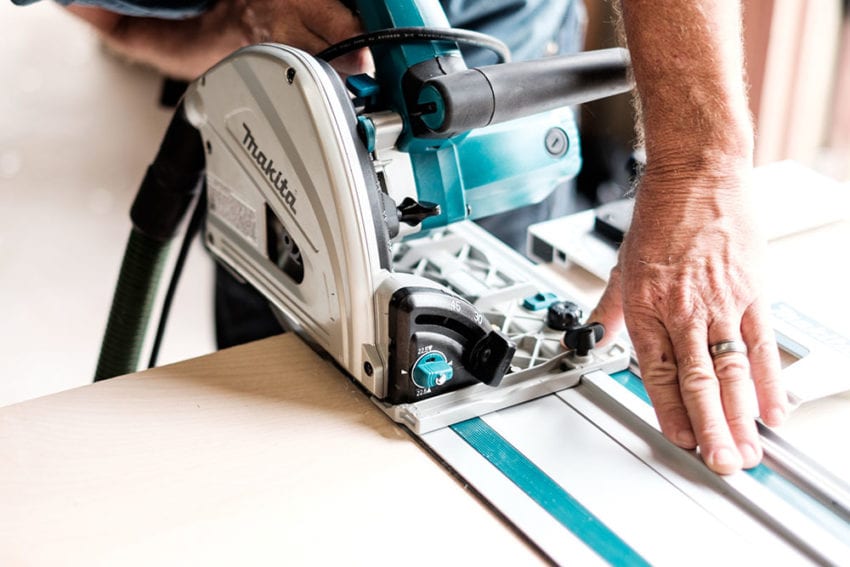
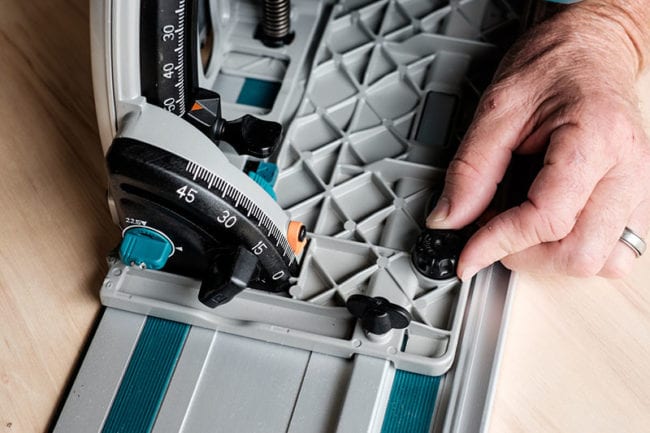
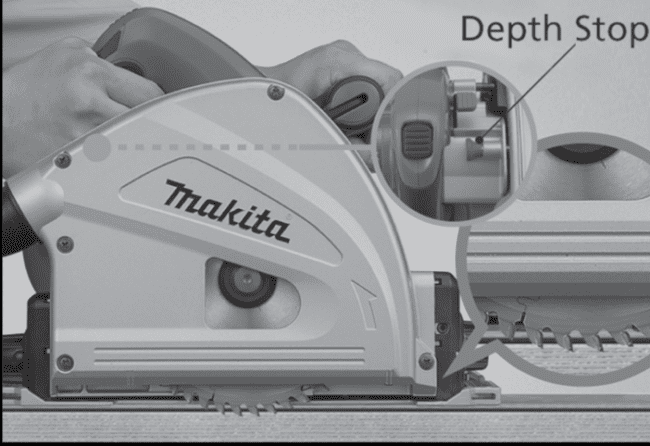
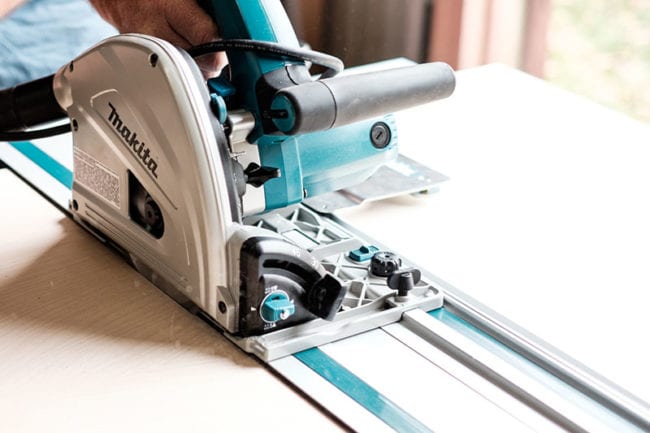
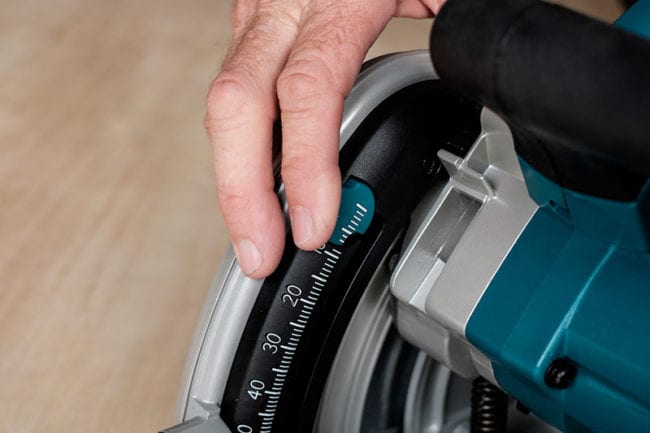
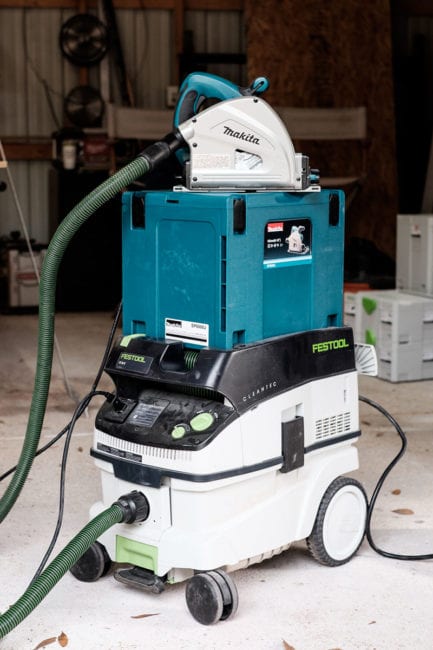
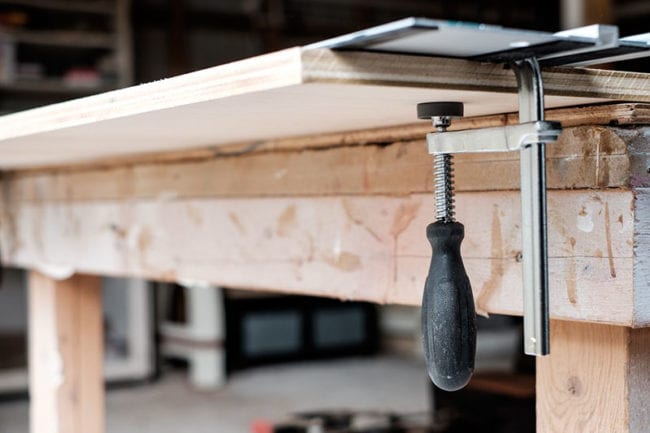
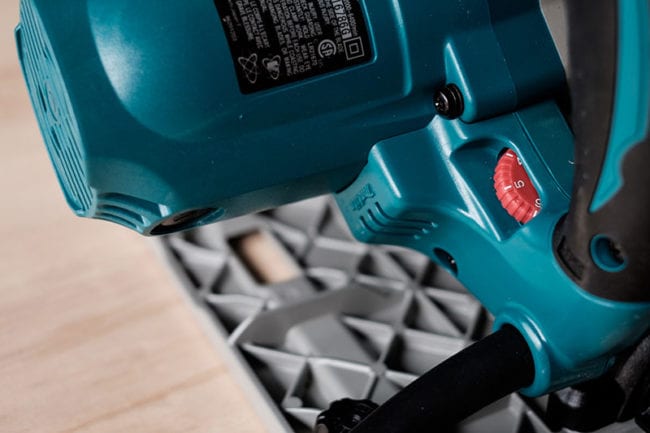
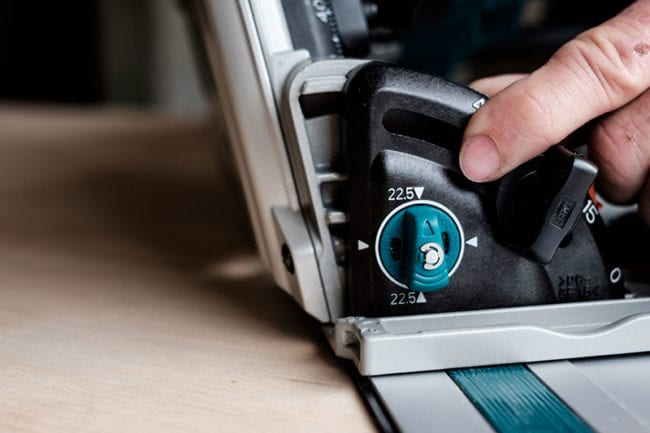
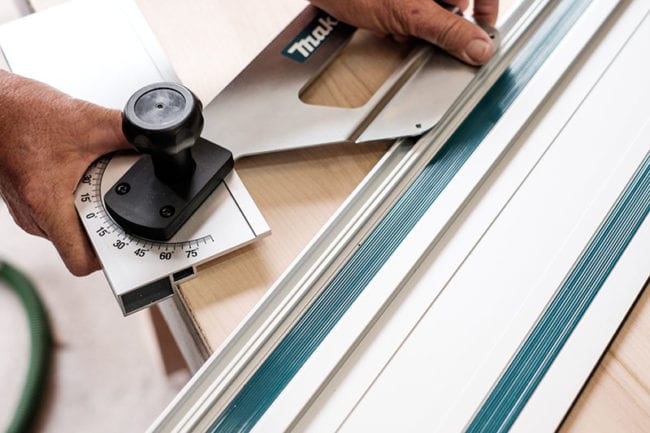
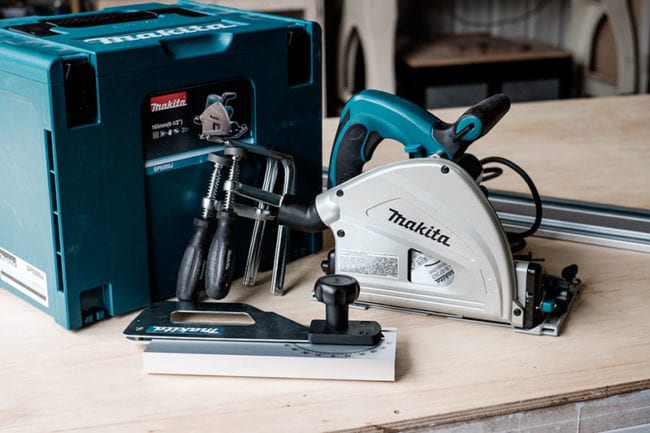


Beware! I bought this saw and owned it for about 2 hours and took it back to the retailer. What the reviews don’t tell you is when you try to perform an angled cut the saw does not travel smoothly as when cutting a 90 degree cut. The problem is with the round washer that travels in the track (to keep the saw from lifting off the track). The washer is loose so it will travel in the track however when you cut an angle the washer locks up. When angling the saw on the track the saw causes undue… Read more »
Great saw. I own the cordless Makita Track Saw and the cordless DeWalt track saw. Both very good tools. I’ve used the Festool saws plenty and would still buy one of the two I own unless I were in to the whole Festool shop system. The dust collection on this saw is very good. My dewalt is ok for dust collection. I prefer the plunge mechanism on the dewalt and I prefer the DeWalt Track. The DeWalt blade path for plunge cuts goes down and forward into a cut. All of the pivot saws enter the cut on an arc… Read more »
This saw is a piece of crap. A cheap festool knockoff. I’ve gone through 3 tracks, not one was straight or not cupped. I’m not the first one with this issue. Many complaints about poor quality of makita tracks on the net…
Also it ships in a case with no foam support and the saw gets banged around and damaged.
Good Review. I wasn’t sure whether to go for the Festool or the Makita, having only used the Festool previously, but I was leaning towards the Makita, as most of my power tools are already Makita. You have helped me make up my mind on the side of the Makita. On a side note, you mentioned that the measurements are in metric, instead of imperial. This is because in the vast majority of the world, (including Europe, Asia, Australia and most of Africa) metric measurement is the standard, not imperial. The U.S. and Britain are in a very select group… Read more »
I’ve had this saw for about 6 years, after several years of Festool track saw use at a different shop, and I can say with certainty that the Makita is the better saw. It’s a little more powerful than the festool – not enough to matter in everyday woodshop use, but the power difference is noticeable in thick hardwoods, composites, and solid surface work. We removed the riving knives from our festool saws because they would hang up on plunge cuts and mar delicate finished surfaces. The only reason I’d recommend the festool saw is if you’re already using a… Read more »